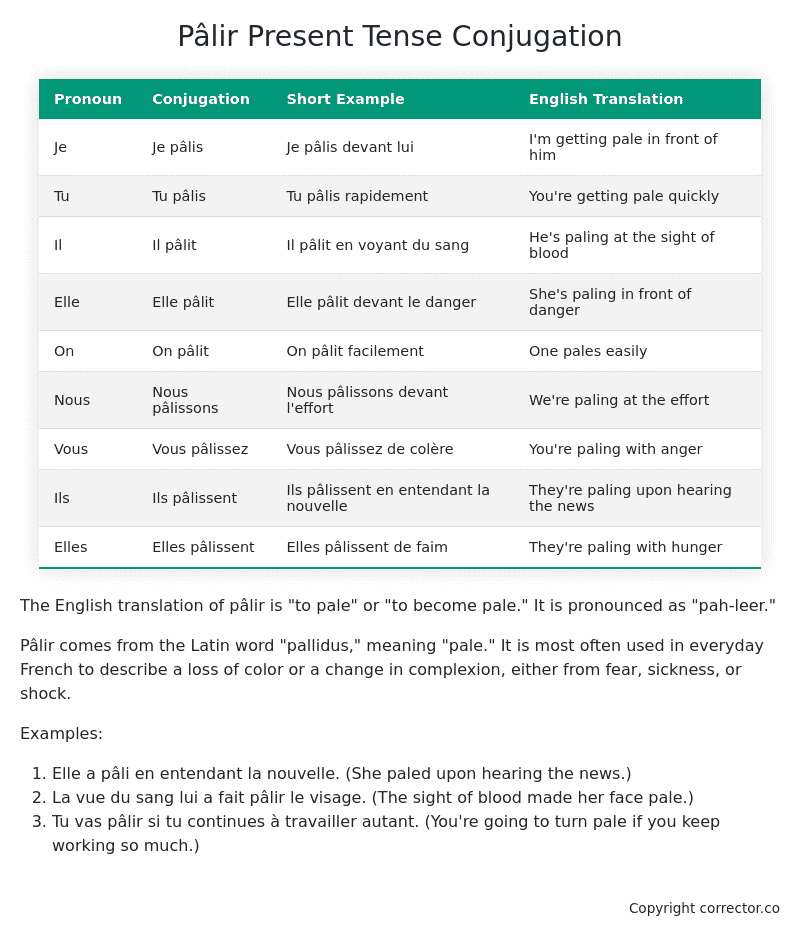Le Present (Present Tense) Conjugation of the French Verb pâlir
Introduction to the verb pâlir
The English translation of pâlir is “to pale” or “to become pale.” It is pronounced as “pah-leer.”
Pâlir comes from the Latin word “pallidus,” meaning “pale.” It is most often used in everyday French to describe a loss of color or a change in complexion, either from fear, sickness, or shock.
Examples:
- Elle a pâli en entendant la nouvelle. (She paled upon hearing the news.)
- La vue du sang lui a fait pâlir le visage. (The sight of blood made her face pale.)
- Tu vas pâlir si tu continues à travailler autant. (You’re going to turn pale if you keep working so much.)
Pâlir – About the French Present Tense
To take a deep dive into all the French tenses then see our article on Mastering French Tense Conjugation.
Common Everyday Usage Patterns For Le Present
Interactions with Other Tenses
Table of the Present Tense Conjugation of pâlir
| Pronoun | Conjugation | Short Example | English Translation |
|---|---|---|---|
| Je | Je pâlis | Je pâlis devant lui | I’m getting pale in front of him |
| Tu | Tu pâlis | Tu pâlis rapidement | You’re getting pale quickly |
| Il | Il pâlit | Il pâlit en voyant du sang | He’s paling at the sight of blood |
| Elle | Elle pâlit | Elle pâlit devant le danger | She’s paling in front of danger |
| On | On pâlit | On pâlit facilement | One pales easily |
| Nous | Nous pâlissons | Nous pâlissons devant l’effort | We’re paling at the effort |
| Vous | Vous pâlissez | Vous pâlissez de colère | You’re paling with anger |
| Ils | Ils pâlissent | Ils pâlissent en entendant la nouvelle | They’re paling upon hearing the news |
| Elles | Elles pâlissent | Elles pâlissent de faim | They’re paling with hunger |
Other Conjugations for Pâlir.
Le Present (Present Tense) Conjugation of the French Verb pâlir (this article)
Imparfait (Imperfect) Tense Conjugation of the French Verb pâlir
Passé Simple (Simple Past) Tense Conjugation of the French Verb pâlir
Passé Composé (Present Perfect) Tense Conjugation of the French Verb pâlir
Futur Simple (Simple Future) Tense Conjugation of the French Verb pâlir
Futur Proche (Near Future) Tense Conjugation of the French Verb pâlir
Plus-que-parfait (Pluperfect) Tense Conjugation of the French Verb pâlir
Passé Antérieur (Past Anterior) Tense Conjugation of the French Verb pâlir
Futur Antérieur (Future Anterior) Tense Conjugation of the French Verb pâlir
Subjonctif Présent (Subjunctive Present) Tense Conjugation of the French Verb pâlir
Subjonctif Passé (Subjunctive Past) Tense Conjugation of the French Verb pâlir
Subjonctif Imparfait (Subjunctive Imperfect) Tense Conjugation of the French Verb pâlir
Subjonctif Plus-que-parfait (Subjunctive Pluperfect) Tense Conjugation of the French Verb pâlir
Conditionnel Présent (Conditional Present) Tense Conjugation of the French Verb pâlir
Conditionnel Passé (Conditional Past) Tense Conjugation of the French Verb pâlir
L’impératif Présent (Imperative Present) Tense Conjugation of the French Verb pâlir
L’infinitif Présent (Infinitive Present) Tense Conjugation of the French Verb pâlir
Struggling with French verbs or the language in general? Why not use our free French Grammar Checker – no registration required!
Get a FREE Download Study Sheet of this Conjugation 🔥
Simply right click the image below, click “save image” and get your free reference for the pâlir Present Tense tense conjugation!

I hope you enjoyed this article on the verb pâlir. Still in a learning mood? Check out another TOTALLY random French verb present conjugation!


